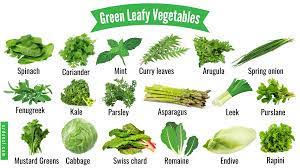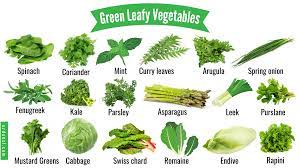Leafy greens are some of the most nutrient-dense foods you can eat, packed with vitamins, minerals, and antioxidants that are essential for good health. From spinach and kale to arugula and Swiss chard, leafy greens come in a wide variety of flavors and textures, making them a versatile and delicious addition to any meal. In this article, we’ll explore everything you need to know about leafy greens, from their origins and history to their many health benefits and how to prepare them.
Origin and History
They have been a staple of the human diet for thousands of years. In fact, some of the earliest known writings on food and health, including the ancient Chinese medical text “The Yellow Emperor’s Classic of Internal Medicine,” mention the healing properties of leafy greens. Throughout history, They have been used for their medicinal properties, as well as for culinary purposes.
What are Leafy Greens?
They are a group of vegetables that are characterized by their green, leafy appearance. It can also include a wide range of vegetables, from lettuce and spinach to kale and collard greens. They are packed with essential vitamins and minerals, including vitamin A, vitamin C, calcium, and iron, as well as antioxidants like beta-carotene and lutein.
What can you eat with Leafy Greens?
It can be eaten raw or cooked, and they can be used in a variety of dishes, from salads and sandwiches to soups and stews. They can also be used as a topping for pizzas and tacos, or blended into smoothies and juices.
Benefits of Leafy Greens
There are many benefits to incorporating leafy greens into your diet. They are high in fiber, which can help to promote healthy digestion and reduce the risk of chronic diseases like heart disease, diabetes, and cancer. They are also low in calories, making them an ideal food for weight management. It’s also rich in antioxidants, which can help to protect the body against cellular damage and inflammation.
How to Prepare Leafy Greens
When preparing this dish, the goal is to retain as many of their vitamins and minerals as possible. Here are some tips for preparing it:
- Rinse the greens thoroughly in cold water to remove dirt and debris.
- Remove any damaged or yellow leaves, and trim the stems if they are tough.
- Chop the leaves into bite-sized pieces.
- Cook the greens by steaming, sautéing, or boiling them. Be careful not to overcook them, as this can cause them to lose their nutrients and flavor.
- Season the greens with salt, pepper, and other seasonings to taste.
Leafy Greens Recipe
Here’s a simple recipe for sautéed leafy greens:
Ingredients:
- 1 bunch of leafy greens (kale, spinach, chard, collard greens, etc.)
- 2 cloves of garlic, minced
- 1 tablespoon olive oil
- Salt and pepper to taste
Instructions:
- Rinse the greens thoroughly in cold water and chop them into bite-sized pieces.
- Heat the olive oil in a large skillet over medium heat.
- Add the garlic and cook for 1-2 minutes, stirring frequently.
- Add the greens to the skillet and sauté for 3-5 minutes, or until they are wilted.
- Season with salt and pepper to taste.
- Serve hot as a side dish or use as a base for a salad or grain bowl.
List of Leafy Greens
Here are some common types:
- Spinach
- Kale
- Arugula
- Collard Greens
- Swiss Chard
- Mustard Greens
- Turnip Greens
- Beet Greens
- Dandelion Greens
- Bok Choy
- Watercress
- Endive
- Radicchio
- Escarole
- Romaine Lettuce
- Iceberg Lettuce

What are the best Leafy Greens to eat?
All these are healthy, but some are more nutrient-dense than others. Here are some of the most nutrient-dense leafy greens:
- Kale: Kale is one of the most nutrient-dense foods on the planet. It’s loaded with vitamins A, C, and K, as well as iron, calcium, and antioxidants.
- Spinach: Spinach is rich in vitamins A, C, and K, as well as iron, calcium, and antioxidants.
- Swiss Chard: Swiss chard is packed with vitamins A, C, and K, as well as iron and potassium.
- Collard Greens: Collard greens are a good source of vitamins A, C, and K, as well as calcium and iron.
- Mustard Greens: Mustard greens are loaded with vitamins A, C, and K, as well as iron and calcium.
Health benefits
They are some of the healthiest foods you can eat. Here are some of their benefits:
- Rich in nutrients: They are packed with vitamins, minerals, and antioxidants that are essential for good health.
- Low in calories: They are low in calories but high in fiber, making them a great food for weight loss.
- Improve digestion: The fiber in it can help improve digestion and prevent constipation.
- Boost immune function: It contain antioxidants and other compounds that can help boost immune function and protect against disease.
- Promote healthy skin: The vitamins and minerals in it can help promote healthy skin and prevent signs of aging.
Frequently Asked Questions
It can be incorporated into many dishes to add a burst of flavor, texture, and nutrients. Whether eaten raw, sautéed, or baked, these greens can elevate any meal. With so many different types available, it can be overwhelming to know where to start. Here are some frequently asked questions about leafy greens:
- What are some common types of leafy greens? There are many types of leafy greens, including spinach, kale, collard greens, arugula, Swiss chard, turnip greens, mustard greens, and beet greens.
- What are the health benefits of leafy greens? They are packed with vitamins and minerals, including vitamin A, vitamin C, vitamin K, folate, iron, and calcium. They are also low in calories and high in fiber, making them an excellent addition to any diet. Studies have shown that eating this may help lower the risk of heart disease, cancer, and other chronic illnesses.
More Info
- How do I prepare leafy greens? To prepare this, first, rinse them thoroughly in cold water to remove any dirt or debris. Then, remove any tough stems or ribs and chop the leaves into the desired size. It can be eaten raw in salads or cooked in a variety of ways, such as sautéed, steamed, or roasted.
- What are some delicious recipes using leafy greens? There are many delicious recipes using leafy greens, such as kale salad with roasted sweet potatoes, spinach and feta stuffed chicken breasts, or Swiss chard and white bean soup. Adding it to smoothies, stir-fries, and omelets are also great options.
- What are some tips for buying and storing leafy greens? When buying leafy greens, look for fresh, bright leaves without any wilting or yellowing. Store them in the refrigerator in a plastic bag or container with a damp paper towel to help keep them fresh. Be sure to use them within a few days of purchase.
Conclusion
These are a versatile and nutrient-packed addition to any diet. Whether eaten raw or cooked, they offer a range of health benefits and can be easily incorporated into a variety of dishes. With so many different varieties to choose from, there’s no excuse not to add more leafy greens to your plate. So next time you’re at the grocery store, don’t forget to pick up some spinach, kale, or Swiss chard and see how easy it is to incorporate these healthy greens into your meals.
See Also: https://infoblog4all.com/quinoa/

